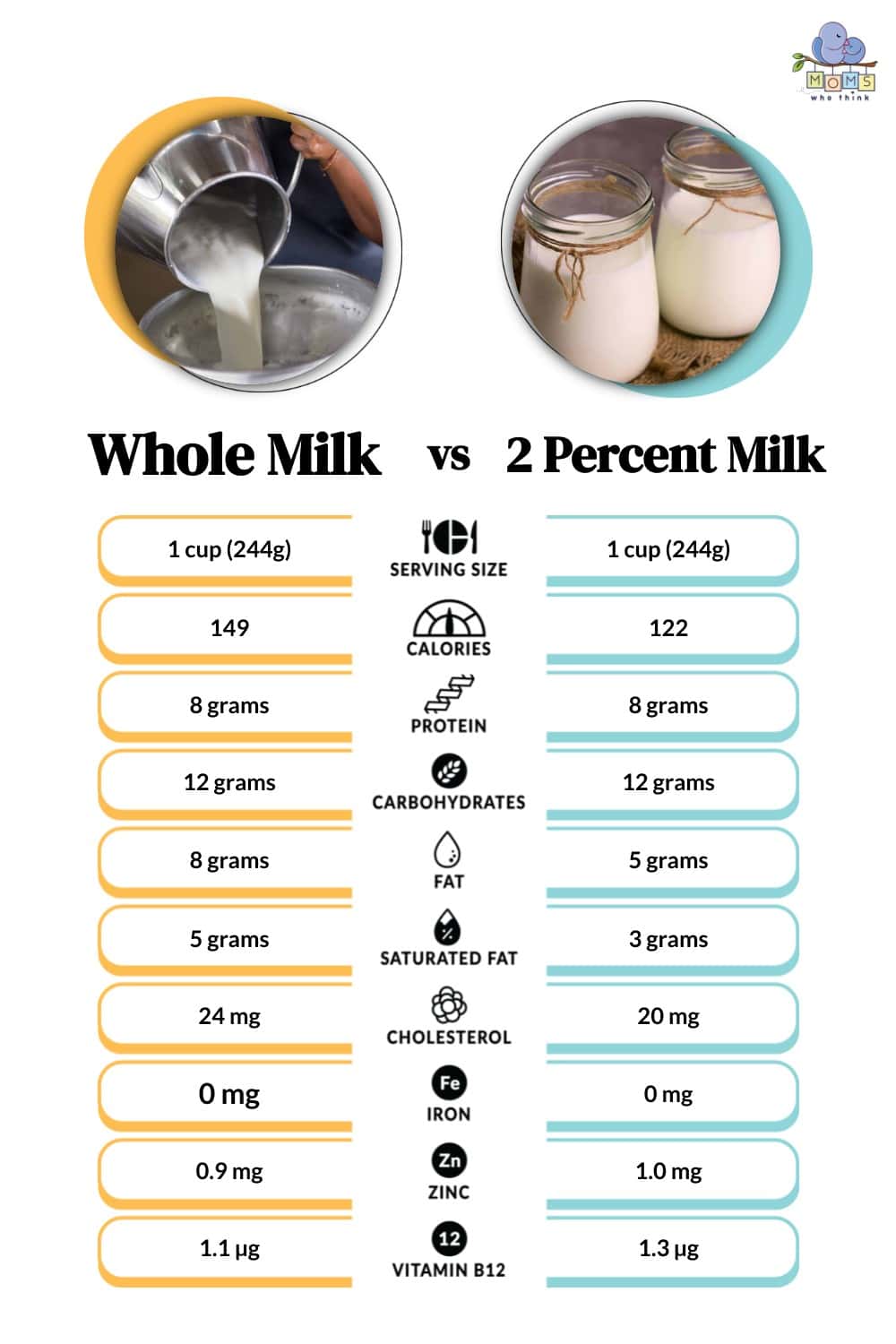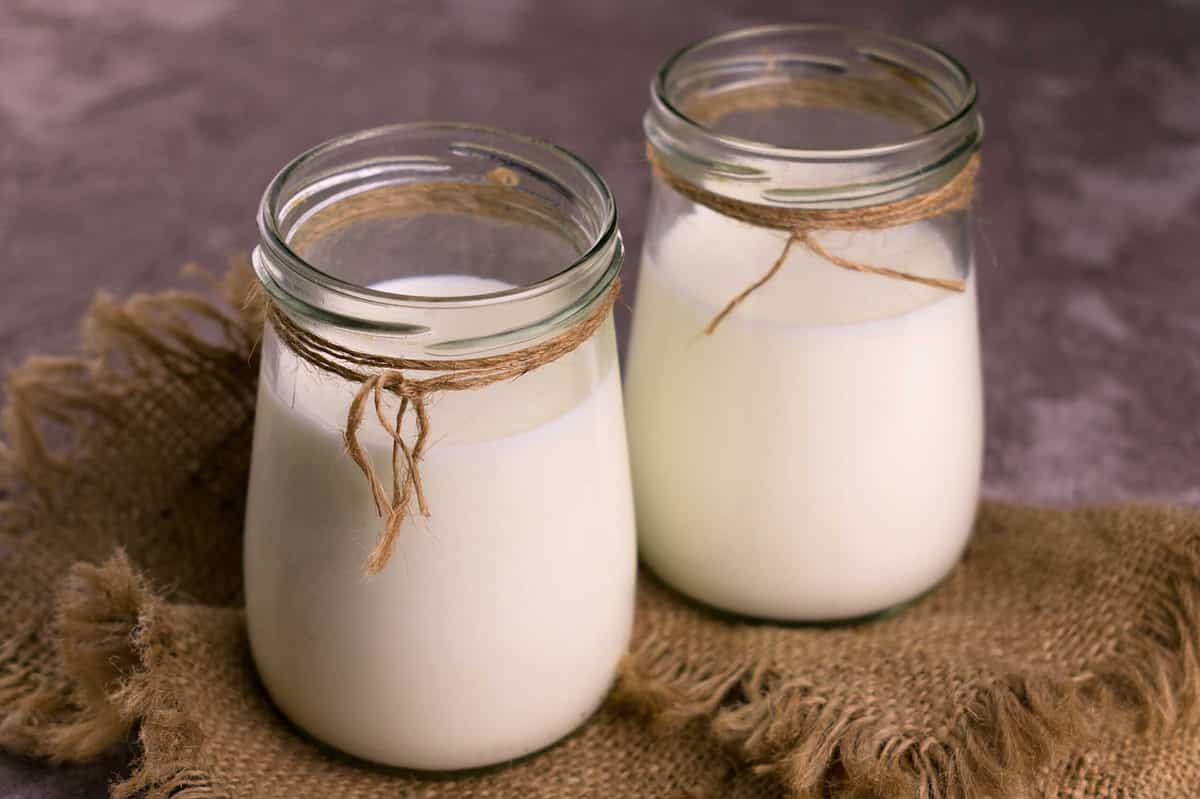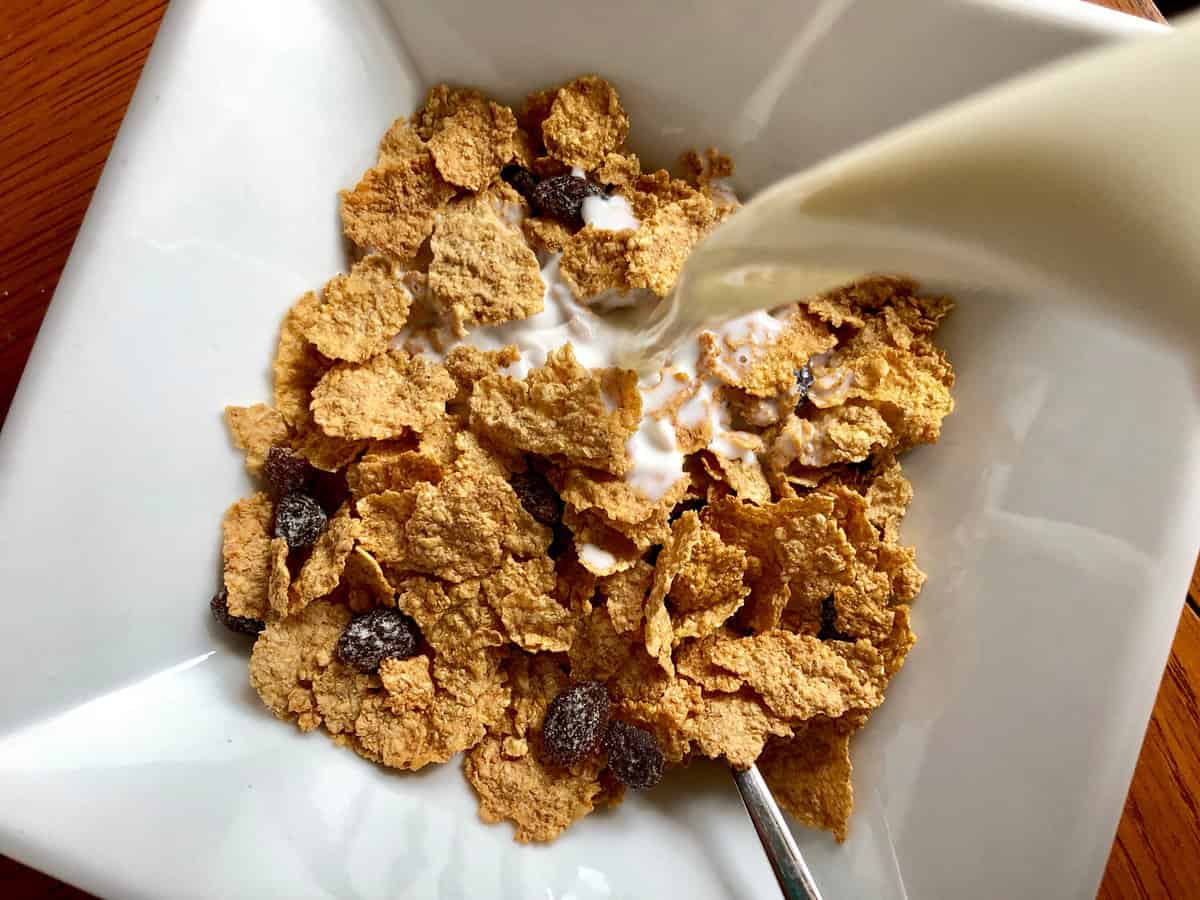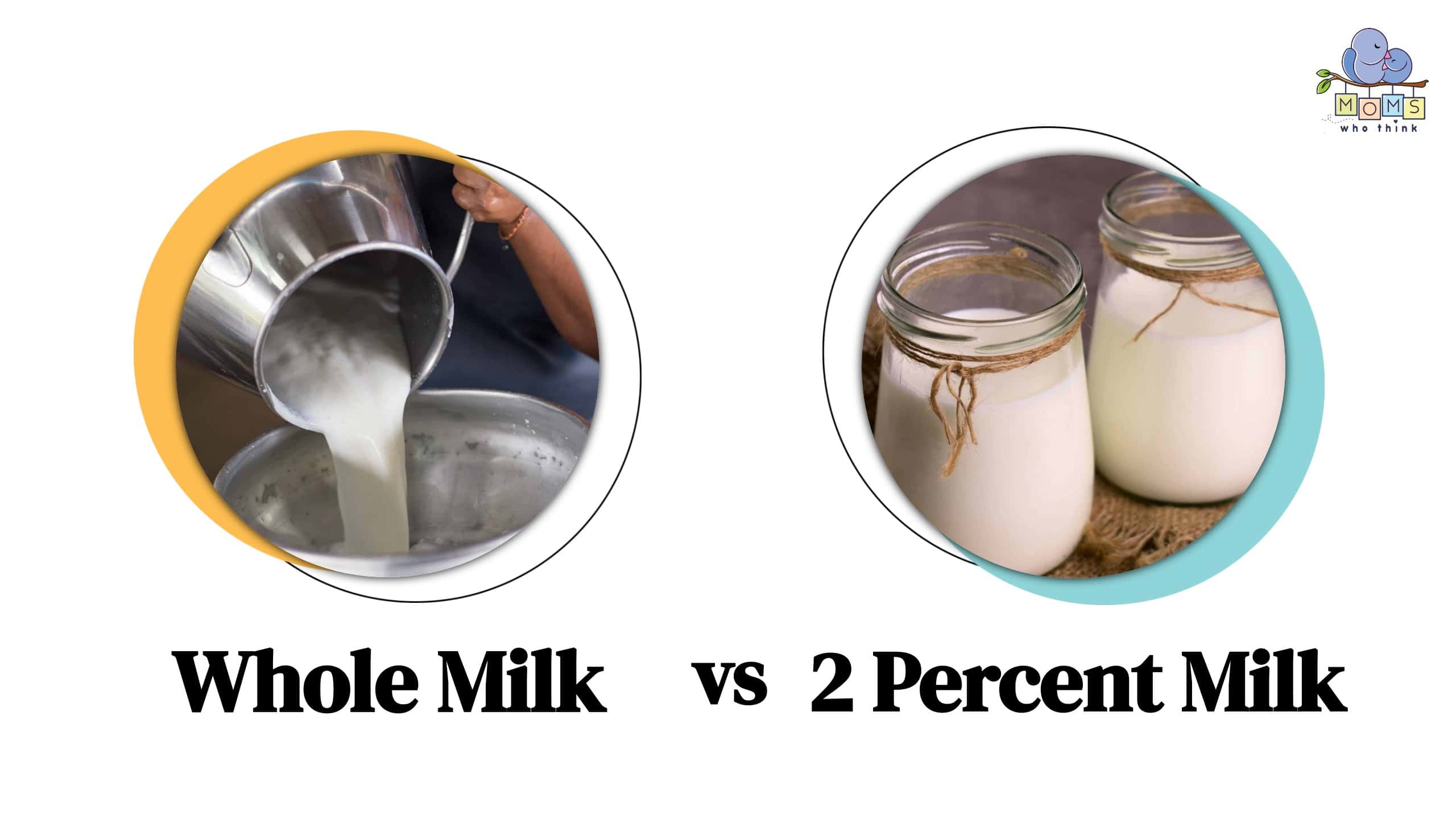Maybe you use it to make your oatmeal in the mornings or you reserve it for creamy coffee. You might be trying a host of new baking recipes, or you just enjoy gulping down a cold glass. But when it comes to whole milk vs. 2% milk, what are the key differences? If you’ve had both, you know the flavor is different. But what else should you consider before making your next milk purchase at the grocery store? Let’s look into it!

Whole Milk vs. 2 Percent Milk: 6 Key Differences
| Whole Milk | 2 Percent Milk | |
|---|---|---|
| Vitamin A | 148.88 international unit (IU) per 1 cup | 183.75 IU per 1 cup |
| Vitamin D | 97.6 IU per 1 cup | 2 IU per 1 cup |
| Saturated Fat | 5 grams per 1 cup | 3 grams per 1 cup |
| Cholesterol | 24 milligrams per 1 cup | 20 milligrams per 1 cup |
| Calories | 149 calories per 1 cup | 122 calories per 1 cup |
| Flavor | Creamy and mildly sweet | Watery and bland |
Whole Milk vs. 2 Percent Milk: Vitamin A
According to the National Institutes of Health (NIH), you need vitamin A in your diet because it serves several important purposes. For instance, it supports your immune system and helps you maintain normal vision. It aids growth and development and ensures that your organs work optimally, including your heart and lungs. Vitamin A also has antioxidant properties. When you don’t have enough of it in your system, it could lead to vision loss. You may also develop issues with your immune system and organs.
One cup of whole milk has 148.88 UI, whereas 2% milk has 183.75 IU per cup. Therefore, 2% milk has a little bit more vitamin A per serving.
Whole Milk vs. 2 Percent Milk: Vitamin D
Your body needs vitamin D for the maintenance of bone health. Vitamin D works in conjunction with calcium to ensure that your body can absorb it for healthy bones. Additionally, vitamin D helps to regulate a host of cellular functions. When you are deficient in vitamin D, you are more likely to experience muscle pain and even bone fractures. This nutrient becomes increasingly important as you age because, without it, you are at a higher risk of experiencing falls.

You can use milk in a myriad ways, but deciding between whole milk and 2 percent milk requires you to take a closer look.
©/ via Getty Images
Whole milk has significantly more vitamin D than 2% milk. Some manufacturers may add additional levels of vitamin A and vitamin D because, with this lower-fat milk option, the natural levels of vitamin D are quite low. Be sure to double-check the nutrition facts of whichever option you select to verify this information.
Whole Milk vs. 2 Percent Milk: Saturated Fat
Saturated fat has long been demonized in nutritional articles. In the 1960s, little research was available on how saturated fats affected the body. Saturated fat therefore developed a reputation of being bad for you. However, according to Harvard Health, saturated fats don’t just provide you with energy, but they also serve as vital building blocks. It’s important to note that saturated fat doesn’t act alone inside your body. It plays a role and is affected by your genes, your physical activity, and the cholesterol and polyunsaturated fat you consume in the rest of your diet. If you are not consuming sufficient saturated fat, you may experience a range of symptoms, including a weakened immune system, hair loss, and even skin rashes.
Whole milk has four grams of saturated fat per cup whereas 2% milk only has three grams of saturated fat per cup.
Whole Milk vs. 2 Percent Milk: Cholesterol
According to Johns Hopkins Medicine, cholesterol is a kind of fatty substance that your body needs for cell membrane production. Additionally, cholesterol serves to produce hormones along with vitamin D. You get cholesterol from the foods you consume but your liver also works to produce the cholesterol you require. Cholesterol is broken down into two primary categories. There is low-density lipoprotein (LDL) cholesterol and there is high-density lipoprotein (HDL) cholesterol.

Depending on your nutritional requirements and weight management goals, you may choose to include 2 percent milk in your meals.
©Jmcanally/Shutterstock.com
Your LDL should remain below 70 milligrams per deciliter (mg/dl) and your HDL should remain around 50 mg/dl. When your LDL cholesterol levels are too high, you are at risk for developing plaque buildup in your arteries, which can lead to stroke or heart attack. Both your LDL and HDL benefit from exercise, maintaining a healthy weight, avoiding foods with high saturated fat, and smoking cessation.
In whole milk, there are 24 milligrams of cholesterol per cup. With 2%, it’s notably less as each cup contains 20 milligrams of cholesterol per cup.
Whole Milk vs. 2 Percent Milk: Calories
The calories you consume work as the fuel your body needs for energy production. When you supply your body with calories, ideally from nutrient-dense foods, you are ensuring your body has what it needs to function optimally. To maintain weight, you consume about the same number of calories as you expend each day. For weight loss, you consume less calories than you burn each day. To gain weight, you consume more calories than you burn in a day.
For those who are on a weight loss journey, the calories present in a cup of milk may be most important. With whole milk, it’s 149 calories per cup. But with 2% milk, you can save on some calories as it comes in at 122 calories per cup.
Whole Milk vs. 2 Percent Milk: Flavor
Whole milk is thicker than 2% milk, offering a rich, creamy flavor experience. Many would say that the taste of 2% milk is reminiscent of whole milk but has a watered-down flavor. While some swear by whole milk only, others have adapted to the flavor of 2% milk. When it’s necessary for a lower-calorie diet, your palate adapts to the flavor, and you often acquire a taste for both 2% milk and other substitutes.

Although you may be accustomed to using whole milk, there is a range of other milk types you can explore, including 2 percent milk. This is particularly important for those who are being health-conscious.
©Luna Vandoorne/Shutterstock.com
Whole Milk vs. 2 Percent Milk: Is One Healthier?
Whether you’re thinking about your own milk consumption or wondering what’s best for your kids, you should know that it’s not a good idea to indulge in full-fat dairy products. Whole milk has saturated fat and if you’re basing consumption on a 2,000 calories per day intake, consider keeping saturated fat consumption less than 20 grams per day. Switching over to 2% milk doesn't have to be an abrupt process. You can slowly transition over time or simply switch between the two options, lowering your consumption of whole milk in the process.
When considering kiddos, the American Academy of Pediatrics Institute for Healthy Childhood Weight put together a Healthy Beverage Quick Reference Guide you can check out. Essentially, children under 12 months should not consume milk. The baby’s needs should be satisfied via breast milk or formula. After 12 months, low-fat and nonfat options are suggested. If your little one becomes accustomed to the flavor of whole milk, you may find that they resist the shift to low-fat and nonfat options. Be sure to check with your kiddo’s pediatrician for advice when making any dietary changes as they can provide customized guidance.
Print
Chocolate Bliss Cake with Whole Milk
- Total Time: 55 minutes
- Yield: 12 servings
Ingredients
For the Chocolate Cake:
- 1 and 3/4 cups all-purpose flour
- 1 and 1/2 teaspoons baking powder
- 1 and 1/2 teaspoons baking soda
- 3/4 cup unsweetened cocoa powder
- 2 cups granulated sugar
- 2 large eggs
- 1 cup whole milk
- 1/2 cup vegetable oil
- 2 teaspoons vanilla extract
- 1 cup boiling water
For the Chocolate Frosting:
- 1 cup unsalted butter, softened
- 1 and 1/2 cups powdered sugar
- 1/2 cup unsweetened cocoa powder
- 1/4 cup whole milk
- 1 teaspoon vanilla extract
- Pinch of salt
Instructions
For the Chocolate Cake:
- Preheat your oven to 350°F. Grease and flour two 9-inch round cake pans.
- In a large mixing bowl, sift together the flour, baking powder, baking soda, and cocoa powder.
- Add sugar, eggs, whole milk, vegetable oil, and vanilla extract to the dry ingredients. Mix until well combined.
- Gradually add boiling water to the batter, mixing until smooth. The batter will be thin, but that's okay.
- Pour the batter evenly into the prepared cake pans.
- Bake in the preheated oven for 30-35 minutes or until a toothpick inserted into the center comes out clean.
- Allow the cakes to cool in the pans for 10 minutes, then transfer them to a wire rack to cool completely.
For the Chocolate Frosting:
- In a large bowl, beat together the softened butter, powdered sugar, cocoa powder, whole milk, vanilla extract, and a pinch of salt until smooth and fluffy.
- Once the cakes are completely cooled, frost the top of one cake layer, place the second cake layer on top and frost the entire cake.
- Optionally, decorate with additional chocolate shavings or sprinkles.
- Prep Time: 20 minutes
- Cook Time: 35 minutes
Nutrition
- Calories: 450
- Sugar: 40 g
- Sodium: 220 mg
- Fat: 25 g
- Carbohydrates: 60 g
- Fiber: 4 g
- Protein: 5 g
- Cholesterol: 85 mg

